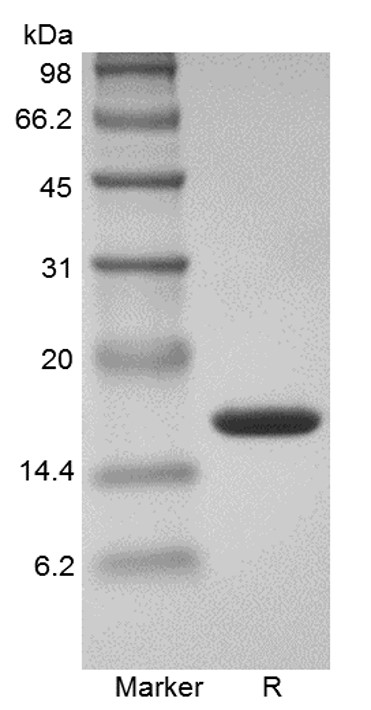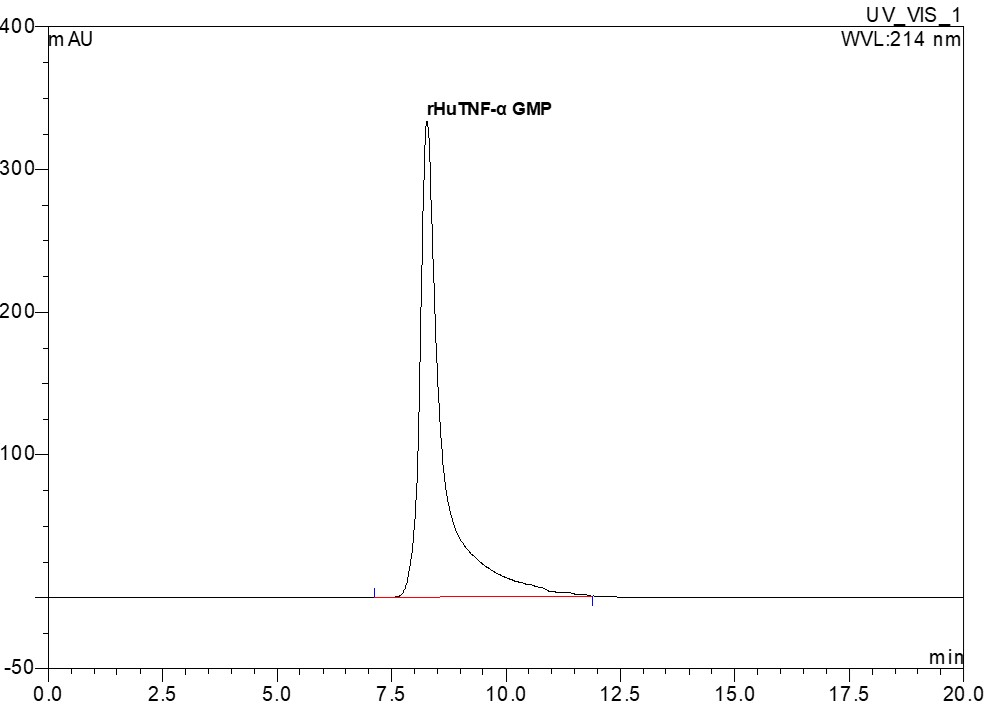- Source
- Escherichia coli
- Molecular Weight
- Approximately 17.5 kDa, a single non-glycosylated polypeptide chain containing 158 amino acids.
- Sequence
- MVRSSSRTPS DKPVAHVVAN PQAEGQLQWL NRRANALLAN GVELRDNQLV VPSEGLYLIY SQVLFKGQGC PSTHVLLTHT ISRIAVSYQT KVNLLSAIKS PCQRETPEGA EAKPWYEPIY LGGVFQLEKG DRLSAEINRP DYLDFAESGQ VYFGIIAL
- Purity
- > 98% by SDS-PAGE and HPLC analyses.
- Biological Activity
- Fully biologically active when compared to standard. The ED50 as determined by a cytotoxicity assay using murine L929 cells is less than 0.05 ng/mL, corresponding to a specific activity of > 2.0 × 107 IU/mg in the presence of actinomycin D, which is calibrated against rHuTNF-α/TNFSF2 WHO International Standard (NIBSC code: 12/154).
- Physical Appearance
- Sterile filtered white lyophilized (freeze-dried) powder.
- Formulation
- Lyophilized from a 0.2 μm filtered concentrated solution in 5 mM Na2HPO4, 5 mM NaH2PO4, 10 mM NaCl, pH 7.0.
- Endotoxin
- Less than 0.01 EU/μg of rHuTNF-α/TNFSF2 GMP as determined by LAL method.
- Sterility
- Negative.
- Mycoplasma
- Negative.
- Host Cell Protein
- Less than 0.05% when tested by ELISA.
- Host Cell DNA
- Less than 20 ng/mg when tested by qPCR.
- In Vitro Virus Assay
- Negative.
- Reconstitution
- Prior to opening, it is recommended to centrifuge the vial briefly to bring the contents down the bottom. Reconstitute in sterile distilled water or aqueous buffer containing 0.1% BSA to a concentration of 0.1-1.0 mg/mL. If animal-origin-free condition is expected in your product, then sterile distilled water is recommended. Stock solutions should be apportioned into working aliquots and stored at ≤ -20 °C. Further dilutions should be made in appropriate buffered solutions.
- Shipping
- The product is shipped with polar packs. Upon receipt, store it immediately at the temperature recommended below.
- Stability & Storage
- Use a manual defrost freezer and avoid repeated freeze-thaw cycles.
- A minimum of 12 months from date of receipt, when stored at ≤ -20 °C as supplied.
- 1 month, 2 to 8 °C under sterile conditions after reconstitution.
- 3 months, -20 to -70 °C under sterile conditions after reconstitution.
- Refer to lot-specific CoA for the Expiry Date.
- Usage
- This material is offered by Shanghai PrimeGene Bio-Tech for research, laboratory, or further evaluation purposes. NOT FOR HUMAN USE.
- Quality Statement
- The manufacturing and testing of these products comply with ICH Q7 guidelines.
- Background
- Tumor necrosis factor alpha (TNF-α), also called cachectin, is the best-know member of the TNF-family, which can cause cell death. This protein is produced by neutrophils, activated lymphocytes, macrophages, NK cells, LAK cells, astrocytes endothelial cells, smooth muscle cells and some transformed cells. TNF-α occurs as a secreted, soluble form and as a membrane-anchored form, both of which are biologically active. The naturally-occurring form of TNF-α is glycosylated, but non-glycosylated recombinant TNF-α has comparable biological activity. The biologically active native form of TNF-α is reportedly a trimer. Human and murine TNF-α show approximately 79% homology at the amino acid level and cross-reactivity between the two species. Two types of receptors for TNF-α have been described and virtually all cell types studied show the presence of one or both of these receptor types.









 COA Application
COA Application


